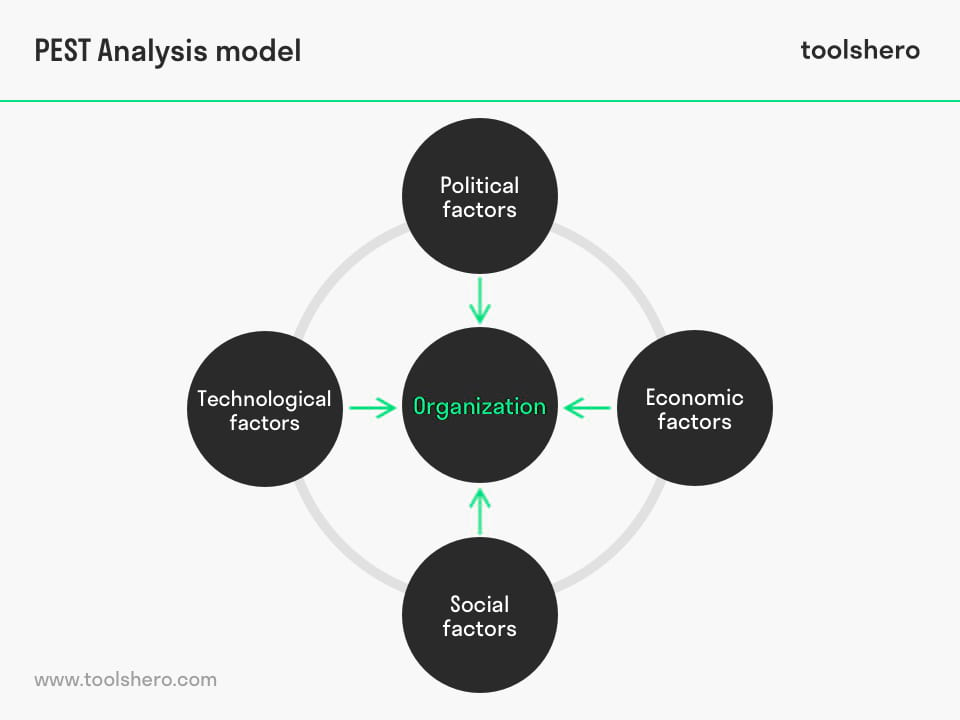PEST Analysis explained

PEST Analysis: this article explains the PEST Analysis by Francis J. Aguilar in a practical way. Next to what is a PEST Analysis, this article also highlights de factors of this analysis and practical tips. Lastly, you will find a real life example of the PEST analysis, using the case of Netflix. After reading you will understand the basics of this macro environment analysis theory. Enjoy reading!
What is a PEST Analysis?
Definition of PEST Analysis
The PEST Analysis is an external analysis in which “P” represents Politics, ‘E’ for Economic, ‘S’ for social and ‘T’ for Technology.
The PEST Analysis describes a framework of macro environmental factors that are important for Strategic Management. It is a useful strategic tool for understanding market growth or decline, business position, opportunities and direction for the possibly required actions.
Founder of the PEST Analysis is Francis J. Aguilar, a Harvard University management professor. He developed this macro environmental analyze tool for market research and scanning the business environment (1967).
Factors within the PEST Analysis Model

Figure 1 – 4 Factors of PEST Analysis
Political factors of the PEST Analysis
Political factors indicate to what extent the Government influences in the economy. These factors are of crucial importance for strategic management. Political factors include areas such as fiscal policy, employment laws, environmental law, trade restrictions, rates and political stability.
Political factors may also include goods and services the Government wants to provide or does not want to provide or be provided (for instance subsidies). Government regulation also has great influence on the healthcare, education and infrastructure of a country or nation.
Economic factors
Economic factors include growth, interest rates, disposal income rates, and the inflation rate of an economy. These factors have a major impact on how businesses operate and make decisions.
For example, interest rates may influence an enterprise’s cost of capital and therefore they may influence to what extent a company grows and expands. Exchange rates may affect the costs of export goods and the supply and prices of imported goods.
Social factors
Social factors are, among other things, cultural aspects and include health consciousness, population growth, age structure, careers and an emphasis on safety. These social factors influence the demand for the products and services of an organization and how this organization responds to this demand.
An ageing population, for example, may imply a smaller and less flexible staff resulting in higher labour costs. Based on social factors, organizations may change their management strategies to adapt to these developments for example by recruiting older staff on account of a shortage of knowledge workers.
Technological factors
Technological factors include ecological and environmental aspects as well as aspects of research and development (R&D) and automation. The rate of technological advancement is an important factor to monitor, especially in the long term, for many organizations. Technological factors influence entry barriers, minimum efficient production levels and in-sourcing and outsourcing considerations.
In addition, technological factors affect the costs and the quality of products and services and often lead to innovation.
Applicability
The factors of the PEST Analysis, political, economic, social and technological factors, will vary in importance to a company based on its industry and the products and services it supplies.
For example, consumers and B2B companies tend to be more affected by the social factors, whereas an organization with a specific service provision to the Government would be more affected by political factors.
Factors that are more likely to change in the future or more relevant to an organization will carry greater importance.
For example, an organization that has to borrow external capital will find that the economic factors (especially interest rates) are becoming more important than the political or social factors.
Example of PEST Analysis for Netflix
Consider the following example of the PEST Analysis for Netflix. You will find Political, Economic, Social and Technological factors affecting the macro environment of the business of Netflix.
Netflix is a media company that offers original and licensed content for a flat monthly fee. Users then get unlimited access to all movies and series on the platform. The service operates in more than 130 countries. The type of content varies by country. Because it operates internationally, it faces many factors and influences, including those from the PEST analysis.
Political factors
The first political factors Netflix faces are censorship and permissions. Netflix is not available in all countries. Therefore, it also cannot offer content from all countries. North Korea, Syria and Crimea are examples. That is the result of decisions made by the U.S. government. Any American company, including Netflix, is prohibited from doing business there.
The U.S. government is not the reason Netflix is not operating China, one of the largest economies in the world. The fault lies with the Chinese government. In fact, China is demanding that Netflix heavily censor their content. Netflix won’t agree to that. Thus, all of the platform’s content is not legally available to everyone. Still, people are getting access, either illegally. One way is VPN. That’s using a Virtual Private Network to extend an existing connection. That way, users from countries where there is no access to the entire database can still access all the content.
Economic factors
Among other things, Neflix is highly susceptible to fluctuating exchange rates. Weaker currencies can seriously affect Netflix’s profit rates. At the same time, they are spending the strong dollar to produce their own content. Other streaming services are on the rise, forcing Netflix to invest more and more money in its own shows and movies.
Customers are getting worried, as subscriptions become more and more expensive and offerings less and less. The solution lies in creating and distributing original content, but that takes time and money. Streaming services such as Disney and Amazon are also pushing hard. In addition, there is such a thing as illegal torrenting. These are illegal providers of the content found on platforms such as Netflix.
Social factors
Employees enjoy working for the Netflix company. There is talk of good working conditions and an informal and relaxed corporate culture. Employees do not have to wear uniforms and are satisfied with the number of vacation days they receive from the company.
Scholarships and training opportunities are also available to employees.
In addition, Netflix’s leadership is known to have the best interests of its staff in mind.
Technological factors
Technological factors affecting Netflix have to do with the user interface, quality of videos and Internet speeds. Customers expect high quality. That makes Netflix responsible for compressing videos without sacrificing quality. That reduces the amount of data needed to stream a video. And that, among other things, is important for Internet speed. Netflix is also keen to operate in areas where internet speed is lower than in other areas. Also, many users face a data limit.
Other acronyms
There are more acronyms for the PEST Analysis, also because additions have been made to the four existing factors. For example, the DESTEP analysis, to which demographic and ecological factors have been added.
STEEPLED
Or a more recent model STEEPLED (Social, Technological Economic, Environmental, Political, Legal, Education, Demographic).
PESTEL Analysis
Another variant is the PESTEL Analysis to which Legal and Environmental factors have been added.
If people want to add another layer at local, national or global level, they could use another variant namely the so-called LoNGPESTEL.
PEST analysis tips
The PEST analysis factors, combined with external micro-environmental factors and internal drivers, can also be classified as opportunities and threats in a SWOT Analysis.
It is important to view the PEST Analysis as a part of an external analysis for conducting strategic planning or strategic analysis. The PEST Analysis provides an overview of the macro environmental factors that are important to an organization.
It’s Your Turn
What do you think? Is the PEST Analysis applicable in today’s modern economy and marketing? Do you use this tool for analysing a target market? Do you recognize the practical explanation or do you have more suggestions? What are your success factors for making up a good PEST Analysis? Do you analyse the political economic social and technological external factors for your business enviornment?
Share your experience and knowledge in the comments box below.
More information
- Aguilar, F. J. (1967). Scanning the business environment. Macmillan.
- Chapman, R. J. (2006). Simple tools and techniques for enterprise risk management. John Wiley & Sons.
- Peng, G. C., & Nunes, M. B. (2007). Using PEST analysis as a tool for refining and focusing contexts for information systems research. In Proceedings of the 6th European Conference on Research Methodology for Business and Management Studies (pp. 229-237). Academic Conferences Limited.
- Thompson, J. and Martin, F. (2010). Strategic Management: Awareness & Change. 6th ed. Cengage Learning EMEA, p. 86-88, 816.
How to cite this article:
Van Vliet, V. (2010). PEST Analysis. Retrieved [insert date] from Toolshero: https://www.toolshero.com/marketing/pest-analysis/
Original publication date: 03/14/2010 | Last update: 09/27/2023
Add a link to this page on your website:
<a href=”https://www.toolshero.com/marketing/pest-analysis/”>Toolshero: PEST Analysis</a>












